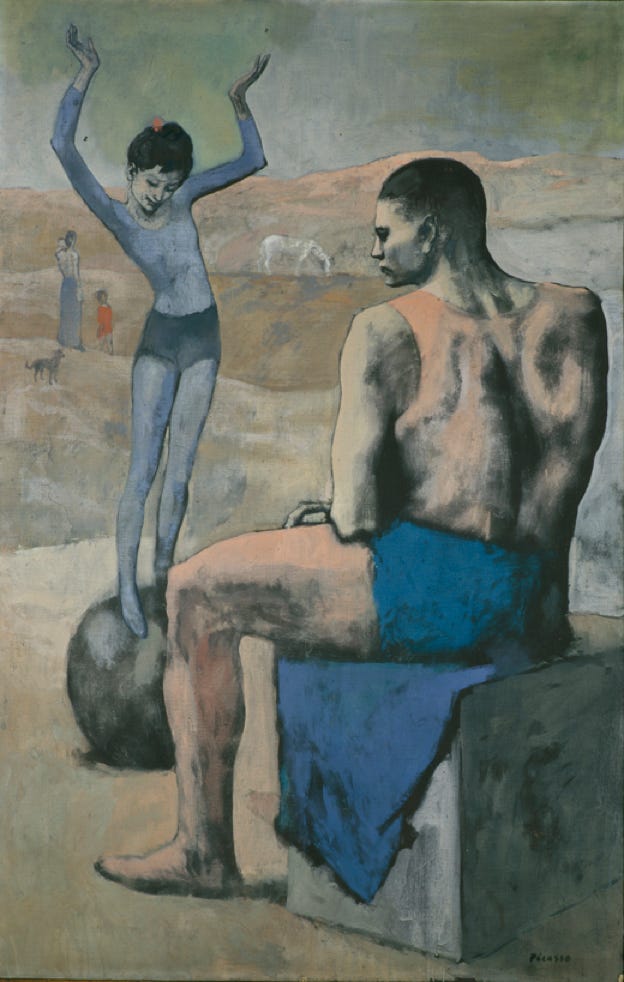Book by Book: Pablo Picasso's Poetry
How visual art can jumpstart creative writing

Happy New Year!
How do we move forward when things are bleak? In 1935, Pablo Picasso suffered divorce and emotional upheaval, stopped painting, and started writing poetry. He wrote to his friend, poet and artist Jaime Sabartés in 1936:
“I abandon sculpture, engraving and painting to dedicate myself entirely to song.”
Similarly, or maybe inversely, when I’m stuck in my writing, sometimes looking at Expressionist or Surrealist paintings helps me. My favorite pieces of art pulse with some sort of emotion that imposes itself over the scenes depicted, distorting reality.
Creating mood—atmosphere, sense of reality or unreality—is very important to me. Imagining how the painter used their hands and brush to create each brush stroke reminds me of the nuts and bolts of writing: sentence structure, word choice, and the sound of words. Each word, if you will, is a brush stroke creating a melody.
I also like to create tone, a sense of fear or disquiet or jubilation. This is different from mood in that it pertains to the character’s attitude rather than general atmosphere. Here, I find again that the brush stroke idea works too. Word choice can often be what leads to a wrong note in a sentence, a dissonance that can be used on purpose to create something interesting—a turn of emotion or another layer of meaning.
I think the goal of every writer is to distort reality, to put forth a version that they see, and that, in their story, is completely valid. It’s in these other realities that we can hold our emotions up to the light and examine them, make sense of them when they trouble us. The ugly can become beautiful, accepted, and dealt with. If I do it right, my fiction should present a reality distorted by emotions, like an Expressionist painting.
In writing, besides imagery and mood, I am most interested in the control of time. Stream-of-consciousness writing, which takes us directly into the mind of the narrator, can lengthen it or shorten it, and the cluster of ideas in one part can create one type of fabric of reality that weaves into another.
Picasso’s poetry lacks punctuation. I find it to be an exercise in creating a quick, immediate, almost timeless stream of words that the reader associates with different things.
The reader blends the words sitting next to each other without regard to typical sentence structure, which forces words into particular meanings.
The lack of punctuation also demands the reader to pay close attention to the rhythm of consonants and the sound of language.
Picasso slings words at the canvas with such freedom. On the similarities between painting and poetry, Picasso wrote:
"After all, the arts are one and the same. You can write a painting in words just as you can paint feelings in a poem."
On punctuation:
“Punctuation is a cache-sexe which hides the private parts of literature.”
This colorful, painted, punctuation-less approach is seen in one of his early poems:
...the blue memory borders white in her very blue eyes and piece of indigo of sky of silver the white white traverse cobalt the white paper that the blue ink tears out blueish its ultramarine descends that white enjoys blue repose agitated in the dark green wall green that writes its pleasure pale green rain that swims yellow green…
“the blue memory” is extremely evocative, and I think of experiences I’ve had that I can describe like this: the blue of the bathroom growing up. The bruise of the blue car on a fated trip pressing down on the earth, moving along the sick yellowish fields. The white of winter and the white of a dead moth. All of the things worth speaking about like this hold urgency and deep emotion, and reconnects me to the verve I’d like to write with.
Picasso’s poetry collection, The Burial of the Count of Orgaz & Other Poems is scatalogical, strangely sexual, and Surrealist.
Some of his earlier work may be a better gateway, and still retains the immediacy of the associative stream of words and painting of emotions that I find helps my own writing so much. I’d like to write, painting my emotions with words like a painter distorts reality.
the artist & his model
turn your back but stay in view at the same time (now look away, anything else confuses)
stand still without saying a word
you can’t see but this is how i separate day from night
and the starless sky
from the empty heart
dogs
dogs eat at the night buried in the yard they chase the moon in a pack the white of their teeth compared to stars
the windows close against them iron bars in transparency
life closes against them
the morning will crush them to dust with only the wind left to stir them up
the morning of the world
i have a face cut from ice a heart pierced in a thousand places so to remember always the same voice the same gestures and my laughter heavy as a wall between you and me
the ones who are most alive seem the most still
behind the milky way a shadow dances
our gaze climbs toward the stars




Loving your thoughts.